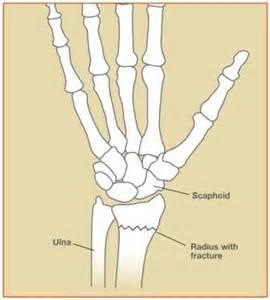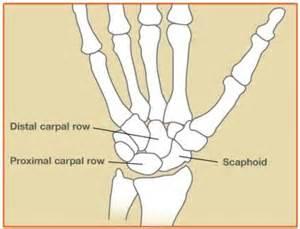Wrist Fractures
The wrist is made up of eight small bones and the two forearms bones the radius and ulna. The shape of the bones allows the wrist to bend and straighten, move side to side and rotate, as in twisting the palm up and down. A fracture may occur in any of these bones when enough force is applied. Many people think that a fracture is different from a break but they are the same.
The two most common types of wrist fractures are distal radius and scaphoid.
Distal Radius Fractures
A distal radius fracture is when the end of the forearm bone, the radius is injured. Often this bone is fractured when there is a fall onto an outstretched hand. When the wrist is broken there is pain, swelling, and decreased use of the hand and wrist. Often the wrist appears crooked and deformed
Examination and xrays are needed to tell if there is a fracture and help determine treatment. Sometimes a CT scan or MRI may be sued to get better detail of the fracture.
Splinting or casting for 4-6 weeks may be the treatment for this fracture. However sometimes surgery is needed to treat this fracture. It is not unusual for maximal recovery from a wrist fracture to take several months.

Scaphoid Fractures
The scaphoid bone is one of the eight small bones that make up the carpal bones of the wrist. Scaphoid fractures are the most commonly fractured bone in the upper extremity. Due to its unique blood supply, scaphoid fractures require appropriate diagnosis and treatment. Fractures of the scaphoid occur most commonly from a fall on the outstretched hand. Usually it hurts at first, but the pain may improve quickly over the course of days or weeks. Many people with this injury mistakenly assume that they have just sprained their wrist. It is common for people who have fractured this bone to not become aware of it until months or even years after the event.
Scaphoid fractures are most commonly diagnosed by xrays. However sometimes xrays taken within the first week of injury appear negative. Therefore a physical exam by the physician is important to determine if a follow up xray in a couple of weeks is appropriate.
Scaphoid fractures can be treated by immobilization in a cast for 6-10 weeks or even longer, due to the slow healing nature of this bone. Surgery is indicted at times to ensure proper healing.



